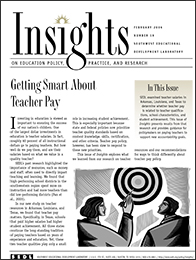Education and Experience: Primary Drivers of Pay
Teachers in the United States are commonly paid using a career ladder approach. That is, those with more years on the job and/or with advanced degrees are paid more. This approach, often referred to as a “single salary structure,” has multiple benefits. For one, it ensures relative pay equity among teachers. Also, it offers district administrators a simple and objective way to determine pay.
It became increasingly important for such an approach to be developed and implemented in education. Pay differences in the early 20th century resulted in pay inequities between men and women, Whites and non-Whites, and high school and elementary school teachers.
In our research on teacher pay and student achievement in Arkansas, Louisiana, and Texas schools, we collected salary, experience, and education data on teachers that would likely have the most impact on learning in core academic areas (see “SEDL Research on Teacher Resources” below). Our research confirmed that the vast majority of these teachers in all three states are paid using a single salary schedule.
More specifically, their years of experience mattered most (see Figure 1). Teachers with more experience made higher salaries and most earned in the upper ranges of salary schedules due to their tenure in the profession. As seen in Figure 2, the majority of teachers had at least 7 years of experience, and a large proportion had 12 or more. In all three states, teachers with more than 21 years of experience made up 20 percent or more of all core teachers.
Teachers holding advanced degrees also earned higher salaries. On average, these teachers earned 4 to 9 percent more than those with only an undergraduate degree.
Teacher pay was less impacted by the following:
- Certification level
- Student poverty and minority enrollment
- District size
- Rural, urban, or suburban location
Unfortunately, we found no solid connections between teacher experience and education and student achievement across all of the states.
Figure 1: Average Teacher Salaries by Years of Teaching Experience

Note. From Arkansas Department of Education (2002–2003), Louisiana Department of Education (2002–2003), and Texas Education Agency (2001–2002).
Figure 2: Teachers Years of Teaching Experience

Note. From Arkansas Department of Education (2002–2003), Louisiana Department of Education (2002–2003), and Texas Education Agency (2001–2002).
Revisiting the Teacher Pay Scale
Our findings underscore a critical question in teacher pay policy: Are we paying for the credentials that will help us achieve instructional goals? So far, research on teacher qualifications, including experience, education, and certification, has yielded no easy answers to what characterizes effective teachers. Dr. Jennifer King Rice, a well-known researcher on teacher quality and school finance, notes that the better we can understand what teachers know and do the more we can really measure the effects of teaching on student learning (Rice, 2003). Improved measures of teacher quality such as subject-area knowledge, evaluation results, and hours of professional development should be created and used to help understand teacher quality.
It is important to recognize that a teacher’s effectiveness cannot be predicted based on one or two criteria. Effective teaching is an interaction among the teacher’s knowledge, pedagogical skill, and classroom management, as well as environmental and other factors. Educators, policymakers, and researchers must find ways to assess these important teacher attributes.
Paying teachers based on criteria that make a difference to student achievement is essential. We have to look beyond the traditional measures of teacher experience and education used in current single salary schedules (Odden & Kelly, 2002).
SEDL Research on Teacher Resources
Our research provides information about the relationship between teacher salary, experience, and education. we used data on “core” teachers collected from state departments of education in Arkansas, Louisiana, and Texas to examine three research questions:
- To what extent do teacher experience and education relate to salary?
- Do teacher salary, experience, and education vary for high-need and non-high-need schools?
- What effects do teacher salary, experience, and education have on student achievement, particularly in high-need schools?
What do we mean by “core” teachers?
Core teachers in our study met these characteristics:
- Taught in the classroom
- Employed a 75 percent or greater in a full-time equivalent (FTE) position
- Taught at only one school
- worked only in an instructional role
These teachers also taught courses that were part of a core academic curriculum established by their state education agency during the 2002–2003 school year (2001–2002 in Texas).
Visit SEDL’s Web site to access our full research report: http://www.sedl.org/pubs/policyresearch/
Next Page: How Well Do We Pay Our Teachers?

